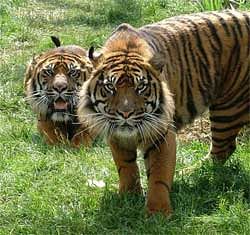Kaziranga: High tiger density may be due to habitat loss

'Aaranyak', an environment watchdog, in collaboration with Assam Forest Department in a recent survey using the 'camera-trap' method has found that the national park, famous for one-horn rhinos, has a density of 38 tigers in an area of 100 square kilometres. According to the last survey done in 2002, the tiger density was 16.7 per 100 square kms.
Describing such an unusual increase of the striped cats in a single protected area could be a dangerous indicator of habitat destruction, conservationist Bibhab Talukdar of Aaranyak recommended regular monitoring of tigers and prey population in the forest. "We would recommend regular monitoring of tigers and prey population to understand the ecology in such a high-density tiger habitat," Talukdar said.
He said the unusual increase might be attributed to habitat destruction in surrounding areas as a result of which these animals flocked to Kaziranga. Due to the high-density, human-tiger conflict in the fringe areas of the park might go up and both short and long term measures were necessary to minimise such conflicts, he felt.
Treating Kaziranga and the adjoining Karbi Anglong hills as a single conservation belt was the need of hour for the long-term survival of the Park and proper dispersal of tiger population, Talukdar pointed out. "Unless the tigers have a wider dispersal area, myriad problems like infighting and conflict with humans is likely to intensify," he added.
The corridors linking Kaziranga with Karbi Anglong forests have suffered extensive degradation due to encroachment, illegal logging, stone mining, growing settlements and tourist movements have severely disrupted wildlife movement, particularly during the flood season, said P J Bora of World Wildlife Fund-India. Man-tiger conflicts have increased in recent years with high incidence of cattle loss reported from fringe villages of Kaziranga. There have been confirmed cases of poisoning of the big cats by affected locals, too.
To ensure the future of the animal, improved management of tiger habitat, including restoration and management of corridors between core areas through land-uses compatible with tiger conservation was necessary, Bora said. "Creating additional or expanding existing protected areas to support viable, breeding tiger populations, and linking them with habitat corridors should be of utmost priority for both proper management of the Park and tiger," Talukdar added.
Deccan Herald is on WhatsApp Channels| Join now for Breaking News & Editor's Picks